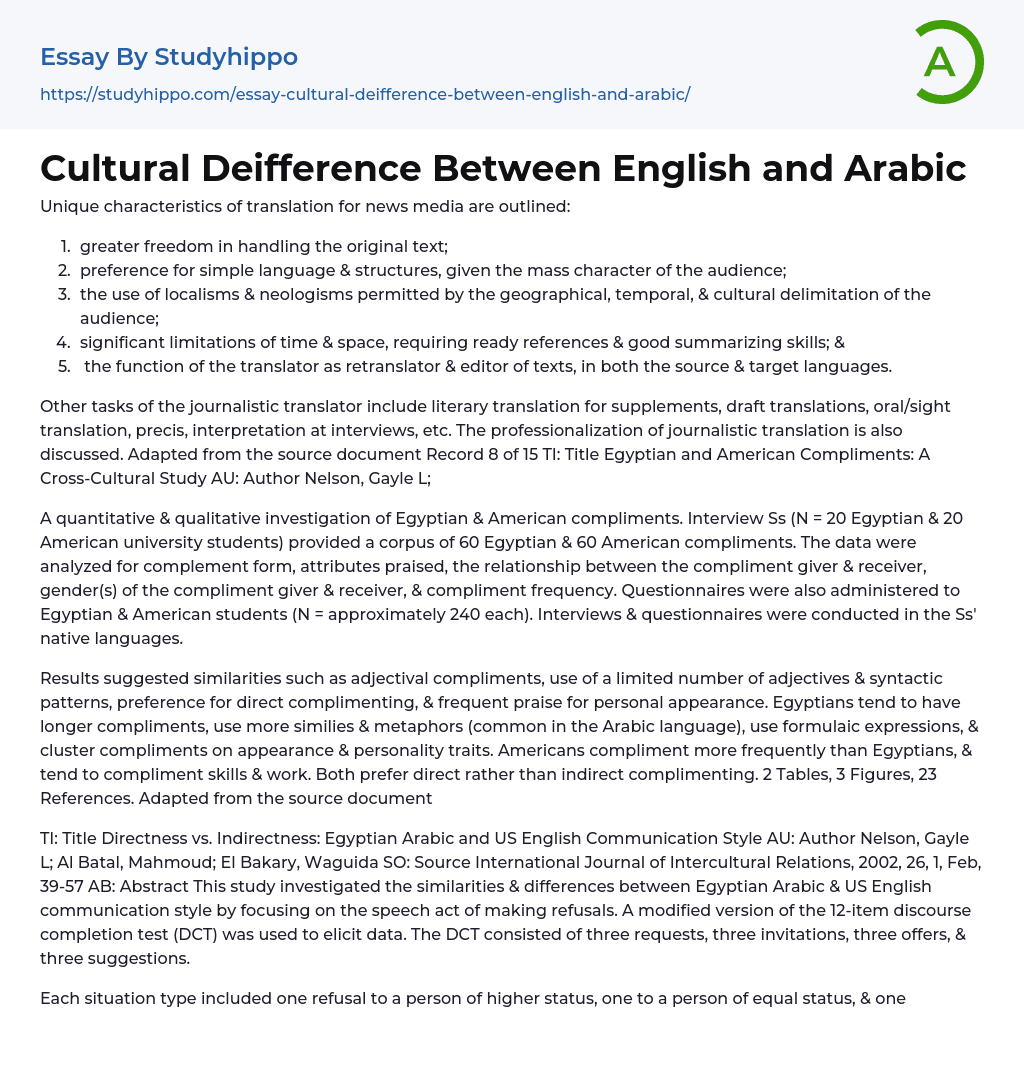

Cultural Deifference Between English and Arabic Essay Example
Unique characteristics of translation for news media are outlined:
- greater freedom in handling the original text;
- preference for simple language & structures, given the mass character of the audience;
- the use of localisms & neologisms permitted by the geographical, temporal, & cultural delimitation of the audience;
- significant limitations of time & space, requiring ready references & good summarizing skills; &
- the function of the translator as retranslator & editor of texts, in both the source & target languages.
Other tasks of the journalistic translator include literary translation for supplements, draft translations, oral/sight translation, precis, interpretation at interviews, etc. The professionalization of journalistic translation is also discussed. Adapted from the source document Record 8 of 15 TI: Title Egyptian and American Compliments: A Cross-Cultural Study AU: Author Nelson, Gayle L;
A quantitative & qualitative investigation o
...f Egyptian & American compliments. Interview Ss (N = 20 Egyptian & 20 American university students) provided a corpus of 60 Egyptian & 60 American compliments. The data were analyzed for complement form, attributes praised, the relationship between the compliment giver & receiver, gender(s) of the compliment giver & receiver, & compliment frequency. Questionnaires were also administered to Egyptian & American students (N = approximately 240 each). Interviews & questionnaires were conducted in the Ss' native languages.
Results suggested similarities such as adjectival compliments, use of a limited number of adjectives & syntactic patterns, preference for direct complimenting, & frequent praise for personal appearance. Egyptians tend to have longer compliments, use more similies & metaphors (common in the Arabic language), use formulaic expressions, & cluster compliments on appearance & personality traits. Americans compliment more frequently than Egyptians, & tend to compliment skills & work.
Both prefer direct rather than indirect complimenting. 2 Tables, 3 Figures, 23 References. Adapted from the source document
TI: Title Directness vs. Indirectness: Egyptian Arabic and US English Communication Style AU: Author Nelson, Gayle L; Al Batal, Mahmoud; El Bakary, Waguida SO: Source International Journal of Intercultural Relations, 2002, 26, 1, Feb, 39-57 AB: Abstract This study investigated the similarities & differences between Egyptian Arabic & US English communication style by focusing on the speech act of making refusals. A modified version of the 12-item discourse completion test (DCT) was used to elicit data. The DCT consisted of three requests, three invitations, three offers, & three suggestions.
Each situation type included one refusal to a person of higher status, one to a person of equal status, & one to a person of lower status. To more closely simulate real-life communication & because Arabic is a diglossic language, an interviewer read the situation aloud & the participants responded verbally on audiotape - Egyptians in Arabic & Americans in English. Audiotapes were transcribed - the Egyptian tapes into Arabic & the American tapes into English. Thirty US interviews resulted in 358 refusals & 25 Egyptian interviews resulted in 300 refusals. The refusals were divided into strategies.
Using a modified version of the coding categories developed by the DCTs creators (Beebe et al), two trained coders categorized the strategies. Intercoder reliability was 89% for the US data & 85% for the Arabic data. Data were analyzed according to frequency types of strategies, the direct/indirect dimension of communication style, gender, & status. Results suggest that both groups use similar strategies with similar frequency in making refusals. They differ, however, in the frequency
of indirect strategies, with Egyptian males using less indirection than Americans. 2 Tables, 1 Appendix, 50 References.
Adapted from the source document TI: Title Arab Cultural Communication Patterns AU: Author Feghali, Ellen Kussman SO: Source International Journal of Intercultural Relations, 1997, 21, 3, Aug, 345-378 AB: Abstract Communication patterns in the Arab world are examined in a review of scholarly work in this area over the past 20 years. "Arab" is defined as anyone who speaks Arabic as a native language & feels oneself be Arab. Work on Arabic communication patterns is categorized according to three themes:
- basic cultural values,
- language & verbal communication, &
- nonverbal & paralinguistic patterns. Issues related to collectivism, hospitality, & honor dominate research on;
- code-switching, communicative style, & the use of indirect & elaborate speech on ;
- interpersonal distance, nonverbal communication & attitude toward time on.
Currently, few scholars possess the necessary linguistic skills to conduct research on these themes within the Arab world, a barrier that must be overcome before sustained naturalistic inquiry into communicative patterns can be accomplished.
- Rabbit essays
- Distribution essays
- Large Animals essays
- Mouse essays
- Poultry essays
- Animal Abuse essays
- Cats Vs Dogs essays
- Cattle essays
- Territory essays
- Popular Culture essays
- Car Culture essays
- American Culture essays
- Mormon essays
- Indian Culture essays
- Mexican Culture essays
- Pop Culture essays
- Cultural Differences essays
- Culture Shock essays
- Different Cultures essays
- Academia essays
- Higher Education essays
- Language Learning essays
- Studying Business essays
- Education System essays
- Study essays
- First Day of School essays
- Scholarship essays
- Pedagogy essays
- Curriculum essays
- Coursework essays
- Studying Abroad essays
- Philosophy of Education essays
- Purpose of Education essays
- Brainstorming essays
- Educational Goals essays
- Importance Of College Education essays
- Brown V Board of Education essays
- The Importance Of Higher Education essays
- Online Education Vs Traditional Education essays
- Academic And Career Goals essays
- Academic Integrity essays
- Brown Vs Board Of Education essays
- Distance learning essays
- Technology in Education essays
- Vocabulary essays
- Writing Experience essays
- Importance of Education essays
- Early Childhood Education essays
- Academic Degree essays
- Academic Dishonesty essays



